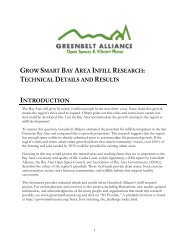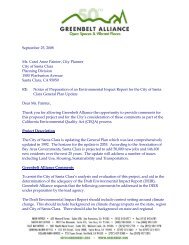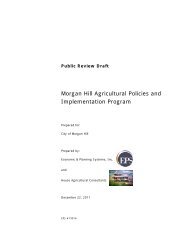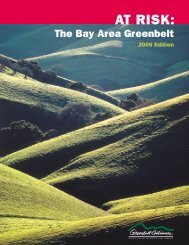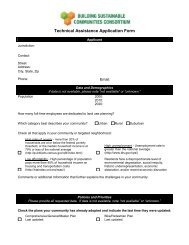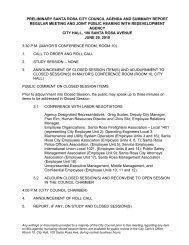Planning For Better Health - Greenbelt Alliance
Planning For Better Health - Greenbelt Alliance
Planning For Better Health - Greenbelt Alliance
You also want an ePaper? Increase the reach of your titles
YUMPU automatically turns print PDFs into web optimized ePapers that Google loves.
The <strong>Health</strong> Issue: <strong>Health</strong> DisparitiesSolution: Equal Access to Produce and ParksPLANNINGFOR BETTERHEALTHQuick FactsFact: There are 51 residential areas in the City of San Jose that do not have access to apark, school, or open space within 1/3 mile.Fact: In one Los Angeles neighborhood, about 20 fast-food restaurants are packed intoa quarter-mile stretch of road. Grocery store chains have historically been less likely tolocate in lower-income communities and communities of color. East Palo Alto, a communityof 30,000 and predominantly Hispanic and African American, approved its firstfull service grocery store in October 2009.Fact: In Los Angeles, white neighborhoods (where whites make up 75% or more of theresidents) boast 31.8 acres of park space for every 1,000 people, compared with 1.7acres in African-American neighborhoods and 0.6 acres in Latino neighborhoods.Fact: A <strong>Health</strong> Report from the City of Berkeley points to evidence that some Californiacommunities display a life expectancy that is 20 years greater in the wealthiest censustracts than in the most impoverished.Key messages you can use ~“It is vital that all residents of a community enjoy equal access to nature, andurban parks provide that visual and mental respite from the busyness of city life.”“Lower-income neighborhoods that are shown to have little to no access to parksmust be prioritized to receive these first as the city expands parkland. Having agreen place to play, walk, and relax benefits people of all ages.”Policy Suggestions• Apply resources to meet parks, recreation, and open space needs in underserved areasof the city, prioritizing lower income and higher density areas, which may have agreater need for these amenities.• Provide access to an existing or future park, open space lands, and/or a major city trailwithin a 1/3-mile radius walking distance of all residents by either acquiring landswithin 1/3 mile or providing safe connections to existing recreation facilities outside ofthe 1/3-mile radius walking distance.• Implement zoning designed to limit fast-food restaurants in overburdened communities.• Identify sites for community gardens and promote the expansion of farmers’ marketsand urban agriculture.• Measure the accessibility of healthy foods by neighborhood to identify nutrition-deficientneighborhoods in a city.Resources & ReferencesLooking for an interactive map to identify park-deficient neighborhoods? Check outwww.parkscore.org.7




